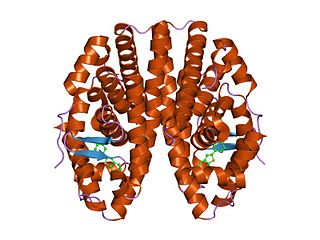Transcriptional adapter 3-like is a protein that in humans is encoded by the TADA3 gene. [4] [5] [6] Cytogenetic location: 3p25.3 [7]
Transcriptional adapter 3-like is a protein that in humans is encoded by the TADA3 gene. [4] [5] [6] Cytogenetic location: 3p25.3 [7]
Many DNA-binding transcriptional activator proteins enhance the initiation rate of RNA polymerase II-mediated gene transcription by interacting functionally with the general transcription machinery bound at the basal promoter. Adaptor proteins are usually required for this activation, possibly to acetylate and destabilize nucleosomes, thereby relieving chromatin constraints at the promoter. The protein encoded by this gene is a transcriptional activator adaptor and has been found to be part of the PCAF histone acetylase complex. In addition, it associates with the tumor suppressor protein p53 and is required for full activity of p53 and p53-mediated apoptosis. At least four alternatively spliced variants have been found for this gene, but the full-length nature of some variants has not been determined. [6]
TADA3L has been shown to interact with:

Histone acetyltransferases (HATs) are enzymes that acetylate conserved lysine amino acids on histone proteins by transferring an acetyl group from acetyl-CoA to form ε-N-acetyllysine. DNA is wrapped around histones, and, by transferring an acetyl group to the histones, genes can be turned on and off. In general, histone acetylation increases gene expression.

Histone acetyltransferase p300 also known as p300 HAT or E1A-associated protein p300 also known as EP300 or p300 is an enzyme that, in humans, is encoded by the EP300 gene. It functions as histone acetyltransferase that regulates transcription of genes via chromatin remodeling by allowing histone proteins to wrap DNA less tightly. This enzyme plays an essential role in regulating cell growth and division, prompting cells to mature and assume specialized functions (differentiate), and preventing the growth of cancerous tumors. The p300 protein appears to be critical for normal development before and after birth.

Estrogen receptor alpha (ERα), also known as NR3A1, is one of two main types of estrogen receptor, a nuclear receptor that is activated by the sex hormone estrogen. In humans, ERα is encoded by the gene ESR1.

The nuclear receptor coactivator 2 also known as NCoA-2 is a protein that in humans is encoded by the NCOA2 gene. NCoA-2 is also frequently called glucocorticoid receptor-interacting protein 1 (GRIP1), steroid receptor coactivator-2 (SRC-2), or transcriptional mediators/intermediary factor 2 (TIF2).

Retinoid X receptor alpha (RXR-alpha), also known as NR2B1 is a nuclear receptor that in humans is encoded by the RXRA gene.

Retinoic acid receptor alpha (RAR-α), also known as NR1B1 is a nuclear receptor that in humans is encoded by the RARA gene.

B-cell lymphoma 3-encoded protein is a protein that in humans is encoded by the BCL3 gene.

Histone acetyltransferase KAT2A is an enzyme that in humans is encoded by the KAT2A gene.

Histone acetyltransferase KAT5 is an enzyme that in humans is encoded by the KAT5 gene. It is also commonly identified as TIP60.

TAF9 RNA polymerase II, TATA box binding protein (TBP)-associated factor, 32kDa, also known as TAF9, is a protein that in humans is encoded by the TAF9 gene.

Transcription initiation factor TFIID subunit 4 is a protein that in humans is encoded by the TAF4 gene.

Transcription initiation factor TFIID subunit 10 is a protein that in humans is encoded by the TAF10 gene.

Transcription initiation factor TFIID subunit 5 is a protein that in humans is encoded by the TAF5 gene.

Tripartite motif-containing 24 (TRIM24) also known as transcriptional intermediary factor 1α (TIF1α) is a protein that, in humans, is encoded by the TRIM24 gene.

Splicing factor 3B subunit 3 is a protein that in humans is encoded by the SF3B3 gene.

Transcription initiation protein SPT3 homolog is a protein that in humans is encoded by the SUPT3H gene.

Transcriptional adapter 2-alpha is a protein that in humans is encoded by the TADA2A gene.

Mastermind-like protein 1 is a protein that in humans is encoded by the MAML1 gene.

EP300-interacting inhibitor of differentiation 1 is a protein that in humans is encoded by the EID1 gene.
In molecular biology there are a number of neurogenic proteins referred to as mastermind-like proteins (MAMLs) of which this domain is the N-terminal region. Mastermind-like proteins act as critical transcriptional co-activators for Notch signaling.